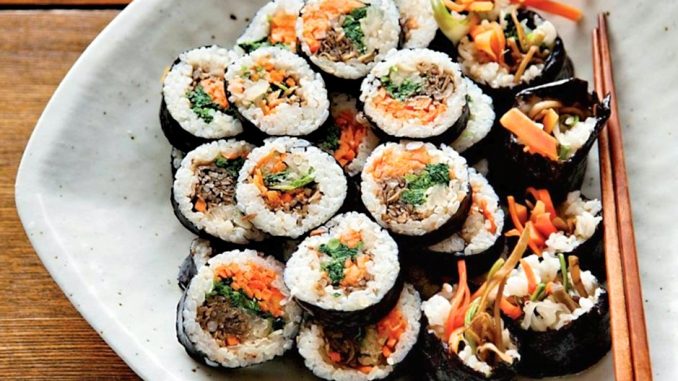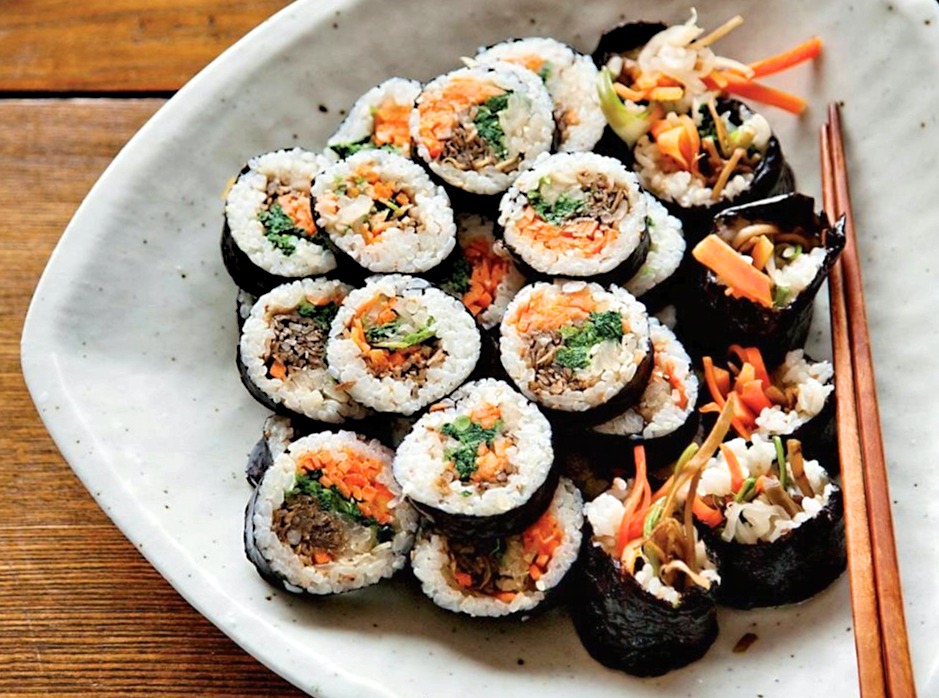
Korean Seaweed and Rice Rolls – Some might think of gimbap or kimbap (pronounced “keem-bahp”) simply as Korean sushi, but it really stands on its own. Wrapped inside layers of roasted seaweed (gim) and steamed rice (bap), the versatile fillings are often cooked and individually seasoned. While sushi rice is always vinegared, the rice for gimbap may be plain or seasoned with any combination of rice vinegar, sesame oil, sesame seeds, sugar, and salt. Finally, unlike sushi, gimbap is usually eaten without any soy sauce, wasabi, or ginger. This makes it a perfect finger food whether you’re at home or on the go.
Now, what about those fillings? The rolls you see here are filled with a traditional combination of bright yellow pickled radish, quickly sautéed carrots, spinach seasoned with sesame oil and salt, and strips of egg — a colorful, multi-textured, and well balanced vegetarian combo. If you’re vegan, you might swap the egg for avocado; if you eat meat, you might add bulgogi (grilled marinated beef) or imitation crabmeat.
A bamboo rolling mat is the only specialized equipment you need, but even that can be improvised. In a pinch you might use a sheet of aluminum foil or your hands to make a looser, more rustic roll. A bamboo mat is inexpensive, though, and we do recommend picking one up from a Korean or Japanese market, a well-stocked cooking store, or on Amazon.
Korean Seaweed and Rice Rolls Recipe
Ingredients:
- 3 cups warm, cooked short-grain white rice
- 2 tablespoons rice vinegar
- 2 teaspoons sugar
- 1/2 teaspoon sea salt
- 1 teaspoon toasted sesame seeds, plus more for garnish
- 5 sheets roasted seaweed (also called gim, nori, or laver)
- 4 to 6 fillings of your choice
- Toasted sesame oil
Fillings shown here:
- 5 pencil-size strips pickled daikon radish (also called danmuji or takuan)
- 1 carrot, julienned and sautéed in sesame oil until crisp-tender
- 4 cups spinach, blanched, squeezed, and seasoned with sesame and salt
- 2-egg omelet with sesame oil and salt, cut into pencil-size strips
- Other ideas for fillings:
- Fresh cucumber, bell pepper, or avocado slices
- Julienned and sautéed burdock root
- Sautéed shiitake or portobello mushrooms
- Kimchi and other pickled vegetables
- Baked or fried tofu
- Cooked meat such as beef, ham, imitation crab, or fish cake
- Equipment
- Bamboo rolling mat
- Small bowl of warm water
- Clean cloth or paper towel
- Pastry brush (optional)
- Cutting board and sharp chef’s knife
Cooking Instructions:
- Season the rice. In a small bowl, stir the rice vinegar, sugar, and salt until the sugar dissolves. Pour it over the warm rice along with 1 teaspoon of sesame seeds and gently but thoroughly mix together. Let cool.
- Organize your workspace. Arrange your ingredients and tools so that everything will be close at hand when needed. Place the bamboo rolling mat on a flat surface with the long side nearest you (the bamboo sticks should be horizontal). Lay out the seaweed sheets, a plate or tray with fillings, and a small bowl of warm water. Also designate a place to put your finished rolls.
- Position the seaweed on top of the bamboo mat. With dry hands, place one sheet of seaweed on the bamboo rolling mat with the shiny side down and the long side nearest you.
- Spread a layer of rice on top of the seaweed. Lightly moisten your hands with water and evenly spread one-fifth of the rice (about 2/3 cup) on the lower two-thirds of the seaweed, leaving the top third of the seaweed empty. If the rice sticks to your fingers as you work, lightly dip them in water (avoid using too much water as it can make the seaweed soggy).
- Arrange the fillings on top of the rice. About an inch up from the bottom of the rice, arrange the fillings in neat, horizontal rows.
- Begin rolling. Beginning on the side nearest you, roll the bamboo mat up and over the fillings. Use firm but gentle pressure to hold the ingredients in place.
- Continue rolling. As you’re rolling forward, pull the mat up and out so it doesn’t get caught in the roll. Keep rolling and releasing the mat until you form a compact cylinder.
- Seal and season the roll. Dip your finger in water and moisten the edge of the seaweed to seal the roll. Wrap the entire bamboo mat around the roll and give it a firm but gentle squeeze. Using your hands or a pastry brush, lightly coat the outside of the roll with sesame oil to give it shine and prevent it from drying out. Set it aside.
- Cut into bite-size pieces. Begin cutting when all the rolls are complete. Using a towel or pastry brush, coat the blade of the knife with a thin layer of sesame oil. Slice the roll into bite-size pieces, periodically wiping the blade and re-applying sesame oil to prevent sticking.
- Garnish with sesame seeds (optional). Sprinkle toasted sesame seeds over the cut rolls.
- Serve. Serve gimbap at room temperature. Best eaten the same day.
Recipe Notes:
Although short-grain white rice has the best texture, gimbap can also be made with short-grain brown rice or other grains. If using leftover rice, warm it up before seasoning with the vinegar, sugar, and salt mixture. No dipping sauce is necessary but if you like, you can use known Korean seasoning sauce or Kikoman.

Looking for other Lutong Bahay Recipes to try on? Feel free to check out our ulam recipes, desserts recipes and snacks recipes.
Some visual and written contents are copyrighted to their respective and considerate owners. We do not claim that these recipes or photos are proprietary to us. If this is yours and you would like it to be removed and not shared with others, please let us know by sending an email to contact @ lutongbahayrecipe.com, you may use our website contact form or by sending a message on our Facebook page. Read our disclaimer.

Leave a Reply